Ford Mustang Mach-E review: muscle car reborn as electric SUV
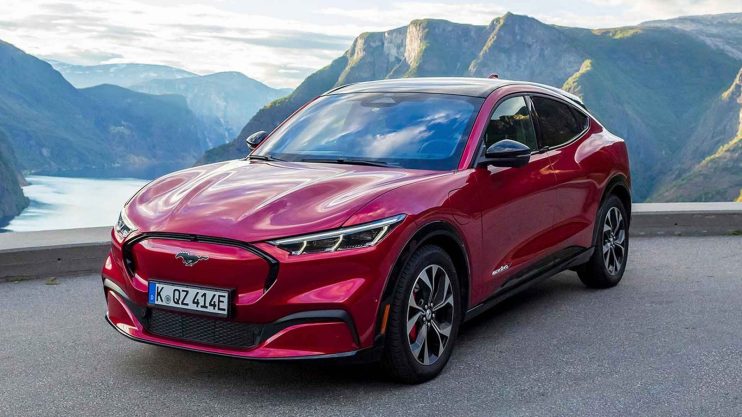
Tesla has already earned its place in history as the company that sparked (no pun intended) the electric car revolution. Pre-Tesla, the most famous EV was the tiny and terrible G-Wiz, which littered London streets for years. The American company changed all that, and customers have flocked to its cars. Indeed, for several months in 2020, the Model 3 was the UK’s best-seller.
To take on Tesla, you have to go bold. Which is exactly what Ford has done with the brilliantly conceived Mustang Mach-E. It takes the cool kudos of the Mustang – the world’s best-selling sports car, no less – and reimagines it as a market-friendly, compromise-free SUV.
Powerful electric motors earn its Mustang stripes. And you can mix and match them in various flavours. The entry-level car has a single motor and rear-wheel drive, with a 75kWh battery and 269hp output. A larger 98kWh ‘Extended’ battery boosts power to 294hp and stretches range from 273 to 379 miles.
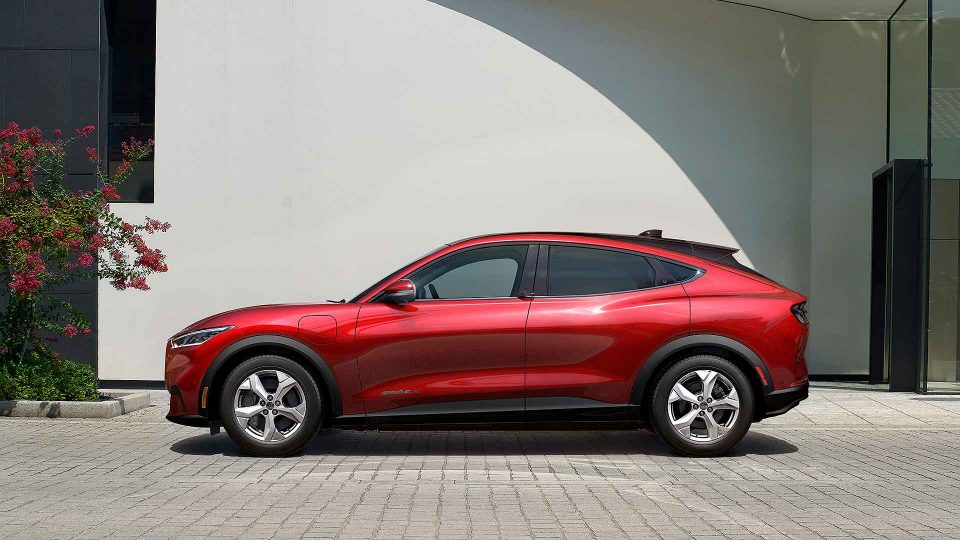
There’s also a dual-motor, all-wheel-drive Mach-E. The standard 75kWh battery produces the same 269hp output and has a 248-mile range, while the 98kWh Extended Range produces 351hp and has a 335-mile range. Confused yet? Squint at the badge on the bottom of the front door to find out what sort of Mach-E it is.
I tested the RWD Extended version, with the longest driving range. Price for the bigger battery does jump rather steeply, from £40,350 to almost £50,000, but more than 100 miles of extra range is handy, as is the ability to use high-power 150kW public chargers.
As soon as it was delivered, Ford’s answer to the Polestar 2, Tesla Model 3 and Volkswagen ID.4 caused a stir. “Is that a Ferrari?”, asked my neighbour. “Wrong sort of horse logo,” I explained – but he didn’t believe me when I told him it was a Ford. The Blue Oval can notch that up as an immediate win.
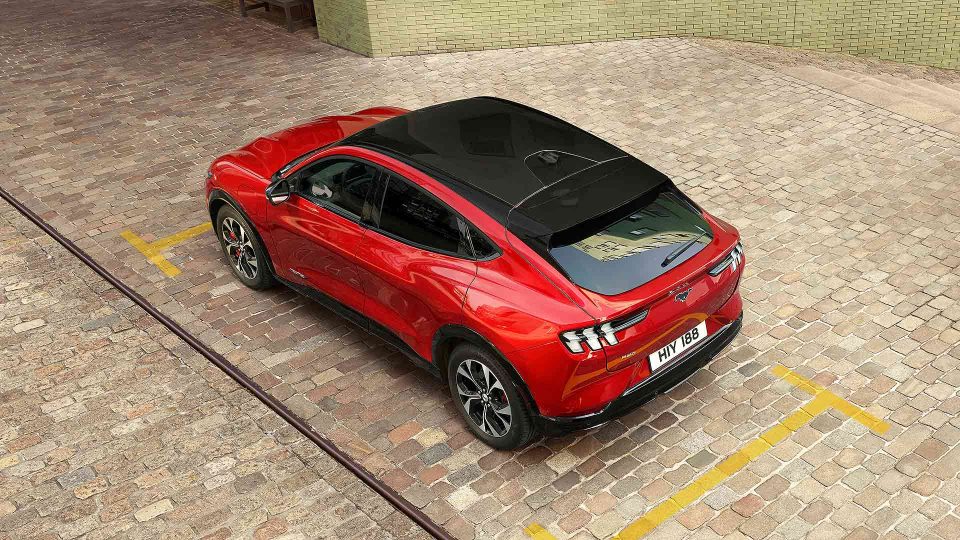
It is a very svelte-looking thing, the Mustang Mach-E. It’s curvaceous and muscular, again living up to its name. It also has a futuristic appearance, helped by the fact it came to market so quickly after its debut.
The fastback roofline is particularly clever. From the side, it looks just like an SUV-coupe. It’s only with a second glance you notice the black-painted extension to the roofline, cleverly hidden in a contrast-colour optical illusion. I also like the trad-Mustang tri-bar tail lamps
It’s quite a large vehicle, more than 4.7 metres long and 1.6 metres tall (you notice the width in tight car parks), but it’s not overbearing, helped by the curves and sculpture. The front end is sealed off, like a Tesla, but has more style, plus the big Mustang horse logo that so confused my neighbour. There’s another one at the rear, and not a Ford badge in sight.
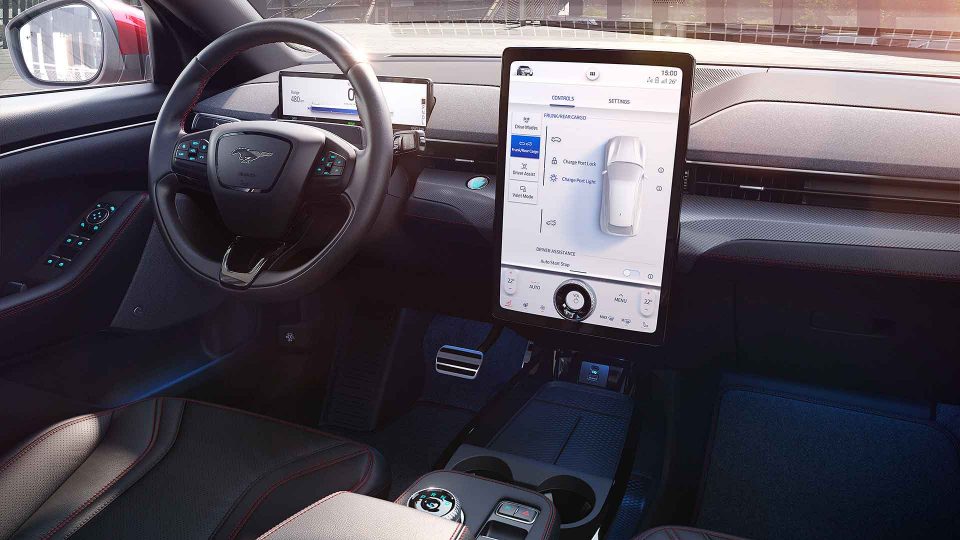
Tesla fans will love the interior because it too has a massive portrait-style central touchscreen. This is naturally intimidating at first, because it replaces almost every button. But Ford’s user interface is actually pretty straightforward and, with a bit of swipe-scroll familiarity, I was surprised at how quickly I got used to it.
The screen is massive and dominates the interior (at times, it almost seemed a touch too big), but Ford hasn’t forgotten to make the other bits welcoming. OK, the plastics aren’t up to Polestar-grade, but they’re a match for an ID.4, and the modern-looking material on the dashboard gives it a contemporary feel. I also loved the B&O ‘sound bar’ stretching across the top of the dashboard.
In front of the driver, there’s a sporty steering wheel wearing another Mustang logo and a smaller electronic display. The seats are surprisingly high-set, which really underlines the SUV vibe (I was more conscious of the top of the windscreen than in many modern cars). As it’s a Ford, the driving position is otherwise perfect.
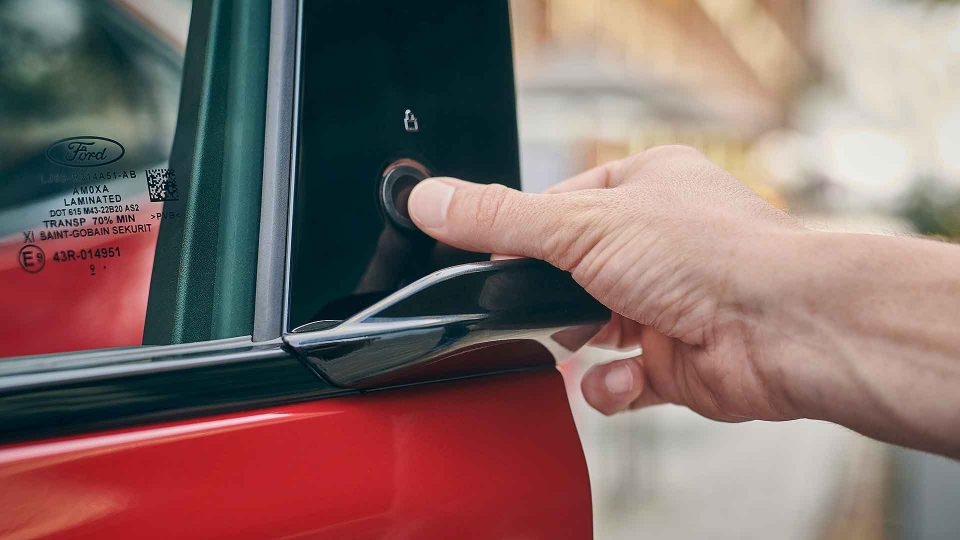
The front door handles are novel: there’s a touch-sensitive button and a fixed lever to pull them open. This actually takes a bit of getting used to, but it’s quite neat, and does facilitate smartphone car keys.
The rear doors are big, and the rear seats are family-sized, with a near-flat floor and comfy chairs, even if it’s a touch gloomy back there unless you slide back the sunshade to reveal the massive panoramic roof.
Boot? It holds 402 litres below the cover and more than 500 litres to the roof, with an extra 81-litre trunk in the front to store the charging cables and other oddments. Ford has even fitted a drainage slot in the front. It allows rainwater to escape when you unplug on a rainy day. Clever.
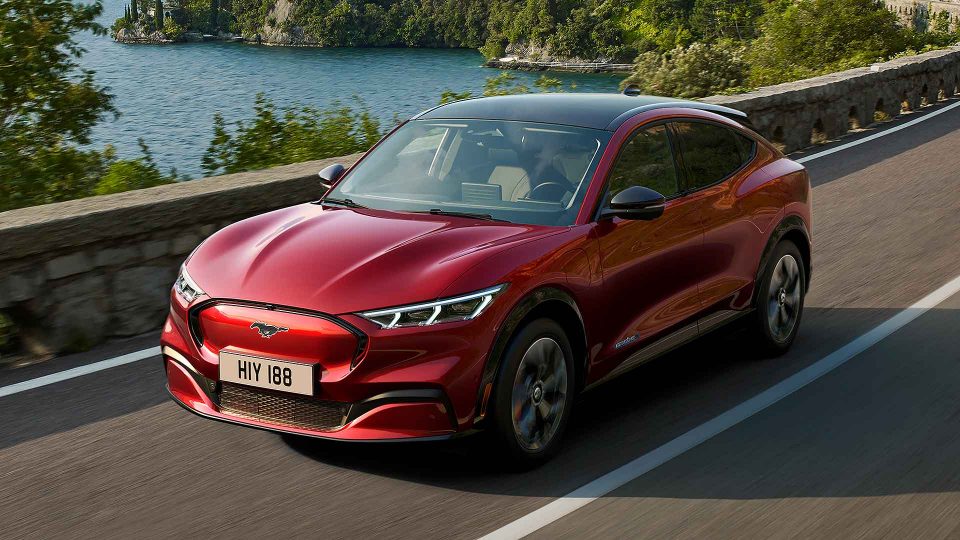
The Mustang Mach-E’s lovely, chunky steering wheel feels sporty, but the steering is surprisingly low-geared by modern standards. The car rolls along almost silently, with low road noise, while the ride is cushioned and compliant. Far from a hard-edged Mustang sports car in disguise, in other words.
But the Mustang coupe has never tried to be as focused as something like a Porsche, and the Mach-E duly follows suit. Instead, as you drive it, you’ll start to warm to its more organic traits, of fine balance, expert chassis setup and faithful, dependable handling. How pleasing to feel such things transfer across from combustion-engined vehicles.
Ford’s chassis engineers have given the European Mach-E a bit of a makeover, so it is sharper than the US version, but it’s still not OTT. It will serve as a fine family car, with just a touch of tautness on undulating roads, plus a real sense of confidence at speed thanks to the low centre of gravity.
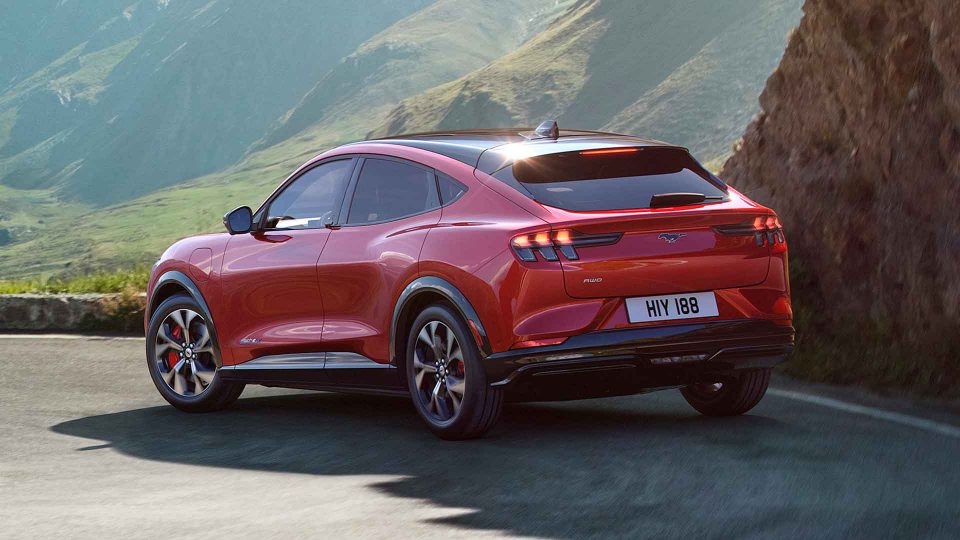
With nicely-weighted steering, an incomparably better ride than the Tesla Model 3 Performance I drove last year, and a generally more fluid and less frenetic feel, the Mustang Mach-E grew on me the more I drove it. This is a well-developed and capable car that’s more than a match for its premium rivals.
The key thing I’d like is just a bit more actual steering feel, particularly as the front wheels are undriven.
What about speed? Although it has almost 300hp, the Mustang also weighs more than two tonnes. Zero to 62mph in 6.2 seconds is brisk, but not neck-jarring – unlike in a Tesla. It’s more the swiftness and cleanliness of response that defines the Mach-E, making it again feel more organic than some other EVs. It’s fun, smooth and sophisticated – and fun on a twisting road.
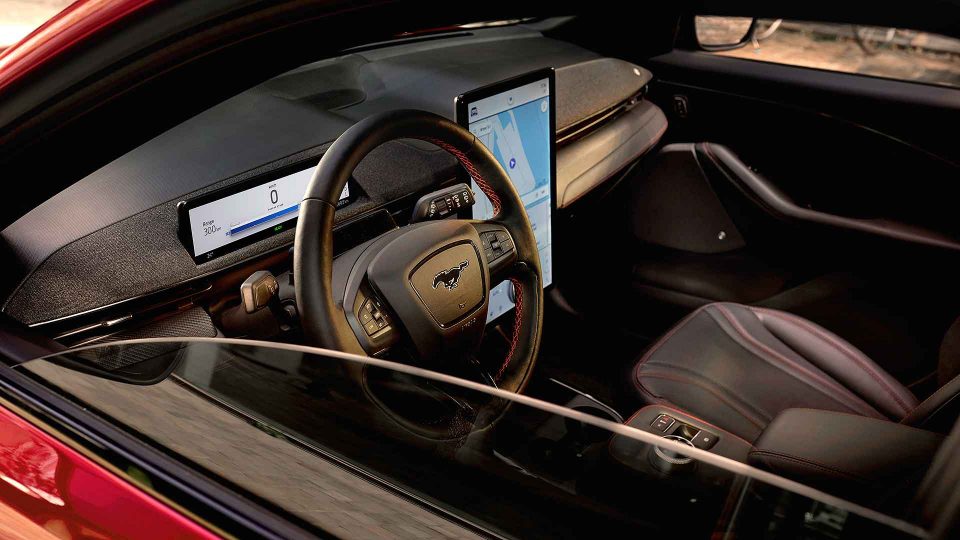
And then there’s the apparent tail-happiness. On a grotty day in March, I finally escaped the motorway and turned onto a twisty road. Swiftly on the power and – whoop! – there’s the rear end stepping out. Stability control sorted it out, but not before I’d instinctively dialled off a bit of steering lock. This was heart-on-sleeve charisma by the bucketload, and it charmed me instantly.
With practice, you can pretend you’re in a proper rear-drive sports car, exploiting the huge torque instantly available to the rear wheels – and even dial back the traction control if you want to take things a step further.
Or you can make it even more thrilling in ‘Untamed’ mode, one of three drive modes alongside Whisper and Active. Untamed is the most alert and focused, and also delivers more of the cute artificial EV noise into the cabin. It was my preferred setting, returning only to the peace of Whisper when back on the motorway.
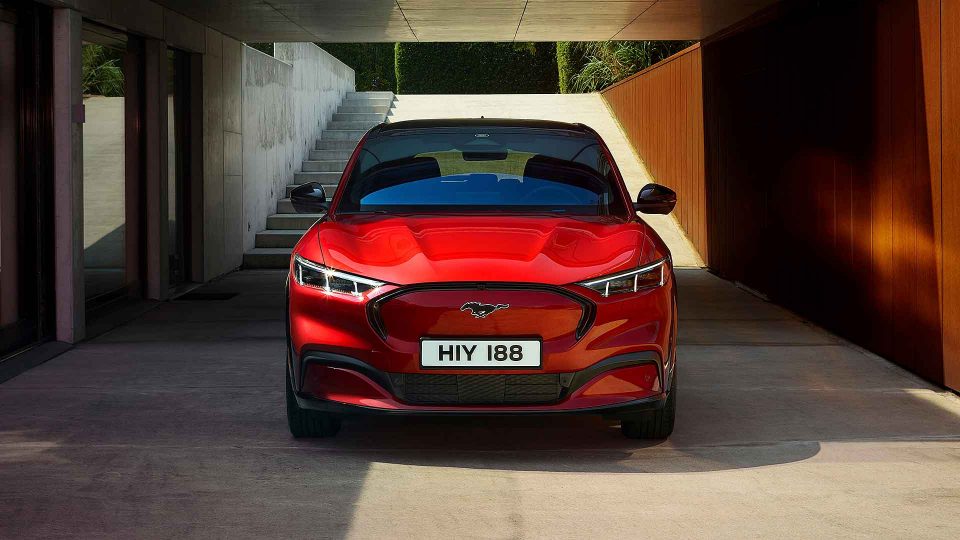
The Ford Mustang Mach-E is a bold statement of intent: the brand’s first pure-play electric car. More conventional models will follow, but what a way to signal your intent. And what a way to get straight onto the radar of Tesla Model 3 drivers.
It’s premium-priced for a Ford, but has the ability and allure to pull it off. This is an enjoyable, well-sorted machine, with headache-free range and loads of everyday family-friendly practicality. A rare car that I liked more and more with every mile I drove, and another great Ford, full stop.
Richard Aucock writes for Motoring Research
PRICE: £49,980
POWER: 294hp
0-62MPH: 6.2 seconds
TOP SPEED: 112mph
ELECTRIC RANGE: 379 miles
WEIGHT: 2,085kg